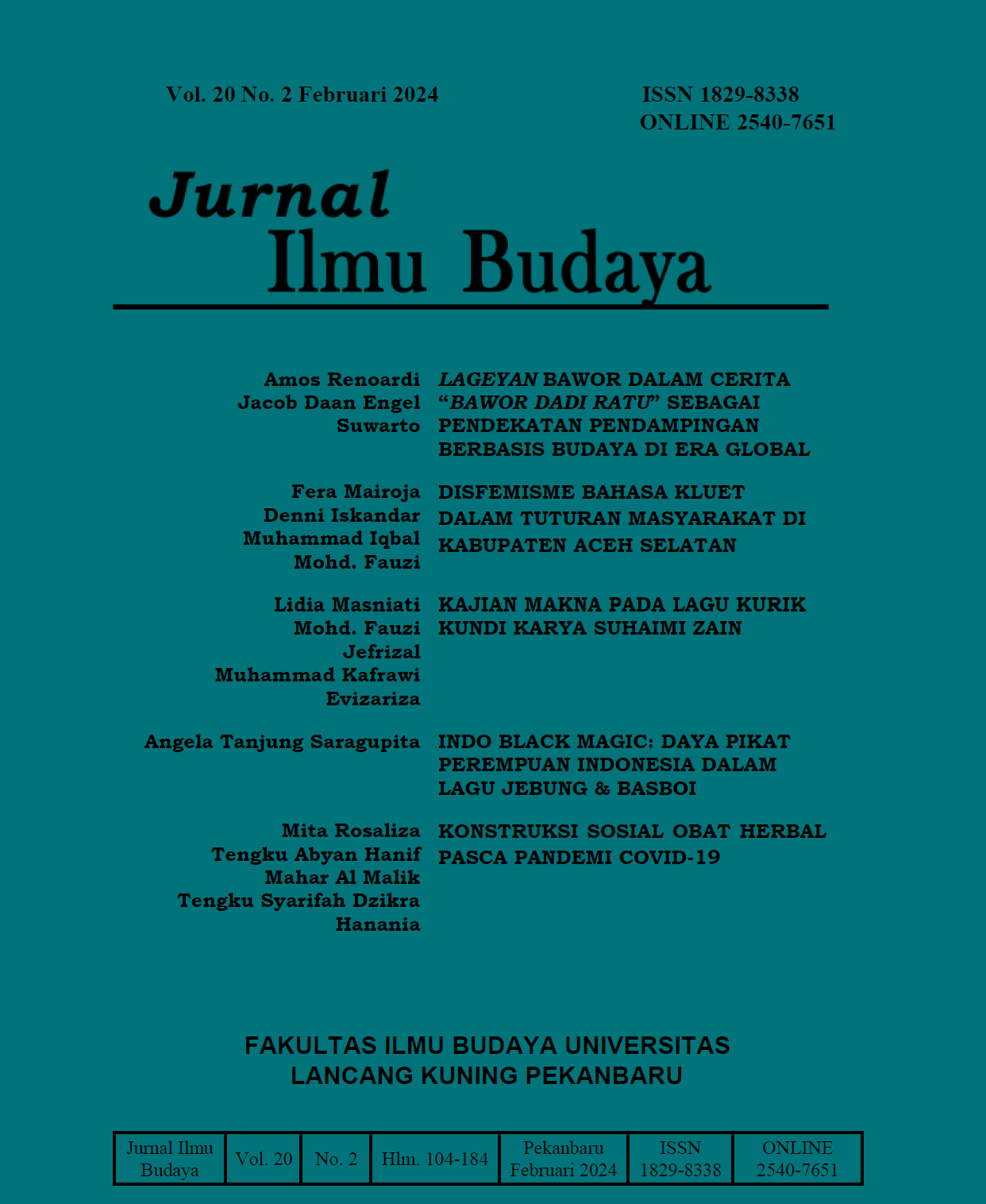DISFEMISME BAHASA KLUET DALAM TUTURAN MASYARAKAT DI KABUPATEN ACEH SELATAN
Abstract
This research intends to (1) explain the form of Kluet language dysphemism, (2) analyze the context of the use of Kluet language dysphemism, and (3) explain the function of Kluet language dysphemism in the speech of the people of South Aceh Regency. This study used a descriptive qualitative method. The researchers took four informants from each sub-district who were used as data sources, namely North Kluet, South Kluet, East Kluet, and Central Kluet Districts. The findings of this research indicate that the form of Kluet language dysphemism contains three forms; the form of words, phrases, and clauses, then context of the use of Kluet language dysphemism consists of the context of habit, anger, talkative/surprised, and prohibiting. Furthermore, the function of using Kluet's dysphemism contains five functions, namely functions to insult, threaten, hurt/annoy, as a joke, and express strong, heavy, and extreme emotions. Conversely, as regards the findings of research and data analysis, the primary forms of dysphemism are phrases and the main context of dysphemism is anger and habit.
Downloads
References
Bolton, K., & Hutton, C. 1997. Bad Boys and Bad Language. Chou Hau and the Socialinguistics of Swearwords in Hong Kong Cantonese. Hong Kong: the Anthropology of a Chineses Metropolis, 299-331.
Bukhari, dkk. 2008. Kluet dalam Bayang-Bayang Sejarah. Banda Aceh: Ikatan Kekeluargaan Masyarakat Kluet.
Chaer, Abdul. 2007. Linguistik Umum. Jakarta: Rineka Cipta.
Creswell, John W. & Poth, Cheryl N. 2016. Qualitative Inquiry and Research Design: Choosing Among Five Approaches. United State of America: Sage Publications.
Creswell, John W. 2014. Research Design, Qualitatives, Quantitative, and Mixed Methods Approcahes (Fourth Edition). United State of America: Sage Publications.
Hasanah, Hasyim. 2016 Teknik-teknik Observasi. (Sebuah Alternatif Metode Pengumpulan Data Kualitatif Ilmu-ilmu Sosial). Jurnal At-Taqaddum, Vol.8 (1): 21-46.
Kabir, Syed Muhammad Sajjad. 2016. Methods of Data Collection. In book: Basic Guidelines for Research: An Introductory Approach for All Disciplines (pp.201-275) Edition: First Chapter: 9. Bangladesh: Chittagong.
Khasan, A.M. dkk. 2014. “Pemakaian Disfemisme dalam Berita Utama Surat Kabar Joglosemar”, Jurnal Basastra, Vol. 2 (3): 1-12.
Laili, Elisa Nurul. 2017. “ Disfemisme dalam Perspektif Semantik, Sosiolinguistik, dan Analisis Wacana”, Jurnal Lingua, Vol. 12 (2):110-118.
Mulyana. 2005. Kajian Wacana: Teori, Metode dan Aplikasi Prinsip-prinsip Analisis Wacana. Yoyakarta: Tiara Wacana.
Nisak, Khairatin dkk. 2018. “Disfemisme Bahasa Aceh dalam Tuturan Anak-Anak di Gampong Ulee Lhat, Montasik, Aceh Besar”, JIM Pendididikan Bahasa dan Sastra Indonesi, Vol. 3 (2): 164-172.
Rizki, Muhammad dkk. 2017. “Disfemisme dalam Tuturan Masyarakat Kecamatan Tapung Hulu”, Jurnal Online Mahasiswa (JOM), Vol. 4 (2):1-6.
Roller, Margaret R. 2017. Qualitative Research: A Collection of Articles from Research Design Review Published in 2016. https://www.rollerresearch.com.
Sari, Yulia dkk.. 2021. “Disfemisme dalam Tuturan Remaja Berbahasa Jamee di Kecamatan Samadua Kabupaten Aceh Selatan”, Jurnal Bahastra, Vol. 6 (1): 88-97.
Sugiyono. 2010. Memahami Penelitian Kualitatif. Bandung: Alfabeta.
Wijana, I Dewa Putu dan Muhammad Rohmadi. 2007. Sosiolinguistik Kajian Teori dan Analisis. Yogyakarta: Pustaka Pelajar.
Zöllner, Nicole. 1997. Der Euphemismus und Politischen Sprachgebrauch des Englischen. Frankfurt am Main: Peter Lang GmbH.
Authors who publish with this journal agree to the following terms:
1. Authors retain copyright and grant the journal right of first publication with the work simultaneously licensed under a Creative Commons Attribution License that allows others to share the work with an acknowledgement of the work's authorship and initial publication in this journal.
2. Authors are permitted and encouraged to post their work online (e.g., in institutional repositories or on their website) prior to and during the submission process, as it can lead to productive exchanges, as well as earlier and greater citation of published work (See The Effect of Open Access).







